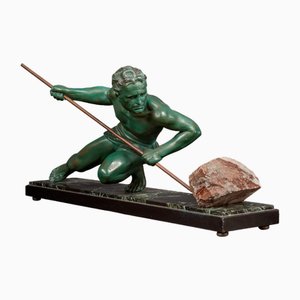Artistic and Historical
This exceptionally beautiful Ethiopian processional cross embodies a long tradition of Christian religious art in Ethiopia, a country where the Orthodox Tewahedo Church has played a central role for centuries. Made of a metal alloy, probably brass or silver, this cross features meticulously chiseled sculptural elements, demonstrating ancestral know-how passed down from generation to generation by Ethiopian artisans.
Processional crosses like this one are carried at the head of religious processions during festivals and liturgical ceremonies, symbolizing faith and divine blessing. They are often richly decorated and adorned with elaborate designs that tell biblical stories, holy stories, and prayers engraved into the metal.
Iconographic Analysis
The cross you shared features complex and rich iconography. Here is an overview of the main figures and their roles in the Ethiopian religious context:
1. Christ Pantocrator: Usually placed in the center or on the upper part of the cross, Christ Pantocrator (King of the universe) is represented blessing with his right hand raised and holding the Gospel in his left hand. This image is central in Orthodox Christian iconography and symbolizes the sovereignty and mercy of Jesus Christ over the world.
2. The Virgin Mary and the Child Jesus: In the center of the cross, we often find a representation of the Virgin Mary holding the Child Jesus. This motif, called "Theotokos" (Mother of God), symbolizes divine motherhood and the incarnation of Christ. Mary is revered as the protector of the Church and is often surrounded by angels, indicating her holiness and special place in Orthodox Christianity.
3. Angels: The depictions of angels on the arms of the cross, sometimes with outstretched wings, symbolize divine messengers and heavenly protectors. They are often depicted holding instruments of Christ's passion, such as the spear or the sponge, thus emphasizing their role in the events of the Crucifixion and their mission to praise and serve God.
4. Prophets and Saints: On the lower or side parts, it is common to find images of Old Testament prophets, local saints, or apostolic figures. Each figure is accompanied by specific iconographic details (books, instruments of martyrdom, etc.) which help to identify their role and importance in the Christian tradition.
Symbolism and Spiritual Meaning
Every detail of this processional cross tells a sacred story and reminds the faithful of the foundations of their faith. The geometric and floral designs that adorn the cross symbolize eternal life, Christ's victory over death, and the promise of salvation for all believers. The circle, often seen around figures, is a symbol of eternity and infinity, indicating the timeless and universal nature of God.
Liturgical Role and Use
Processional crosses play a central role in the rituals of the Ethiopian Orthodox Church. They are carried by priests or deacons during processions, accompanied by liturgical chants, incense, and prayers. The processions themselves are manifestations of public faith, serving to bless participants, communities, and the surrounding lands.
In conclusion, this Ethiopian processional cross is not only an object of religious art, but a powerful symbol of Christian faith and history in Ethiopia. Each engraved element and each depicted figure tells a part of this story, rooted in centuries of devotion, prayer, and religious practice. It is a living testimony to the spiritual and cultural heritage of Ethiopia.



















Get in Touch
Make An Offer
We noticed you are new to Pamono!
Please accept the Terms & Conditions and Privacy Policy
Get in Touch
Make An Offer
Almost There!
To follow your conversation on the platform, please complete the registration. To proceed with your offer on the platform, please complete the registration.Successful
Thanks for your inquiry, someone from our team will be in touch shortly
If you are a Design Professional, please apply here to get the benefits of the Pamono Trade Program